Fire safety in high rise domestic buildings: analysis of consultation responses
Analysis and key findings from our consultation on strengthening fire safety in high rise domestic buildings.
5. Part 2: Fire safety campaign - common areas
5.1 Information on dangers and potential damage
This section of the consultation aimed to gather information to help develop a fire safety campaign regarding common areas in high rise domestic buildings. The campaign will seek to raise awareness on the fire risks associated with any items that might be left in common areas; this includes items that may block access to and exit from buildings, not just those items that will burn.
Question 11. Would having clearer information on the dangers of leaving items that will burn in common areas, encourage people not to do this?
Figure 9. Clearer information on dangerous of items
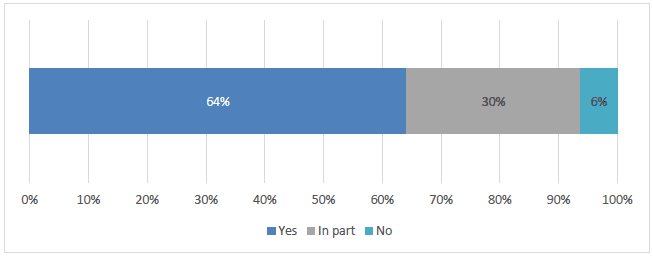
Base: 64
Nearly two thirds (64%) of respondents felt that having clearer information would encourage people not to leave items in common areas. Close to a third (30%) thought that this would be part helpful. Only 6% disagreed.
Table 9. Dangerous Items - follow-up
| Response option | Number answering open follow-up |
|---|---|
| Yes | 20 |
| No | 2 |
| In part | 16 |
The overriding concern of those answering 'In part' was a belief that regardless of how well guidance is presented there will always be some residents who ignore it. Suggested solutions to this included: stricter enforcement with 'zero tolerance'; stronger penalties; and encouragement to report infringements.
Several organisations called for information to be 'hard hitting' and include graphic images of the consequences of leaving flammable items in common areas. One organisation highlighted that common areas also include bin areas and storage areas, not just common walkways, stairs and foyers; and that the dangers are both obstruction and fire risk. One organisation expressed a wish for guidance to emphasise the dangers of flammable items and barbeques on balconies.
"In order to be effective, the information provided to residents must be clear about the approach taken by landlords/building managers to keep common areas clear (i.e. a 'zero tolerance' approach or a 'managed use' approach), whose responsibility it is to keep these areas clear, and why this is so important for all residents.
This should also be matched by appropriate enforcement from landlords/building managers to ensure that residents are adhering to this approach."
Chartered Institute of Housing Scotland
Those who answered 'Yes' had similar concerns to those answering, 'In part'; calling for 'hard hitting visuals' to illustrate the dangers.
One individual owner-occupier was concerned about the particular danger of Christmas trees in public areas.
A tenants' organisation suggested that CCTV might dissuade residents from leaving items in public areas.
Question 12. Would images to highlight the damage caused by fires started in common areas be helpful to encourage people not to leave items that will burn in those areas?
Figure 10. Images on Dangerous Items - whether helpful
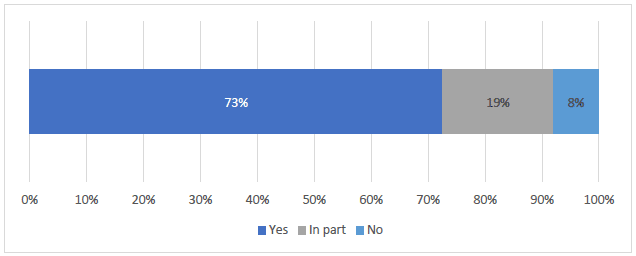
Base: 62
About three quarters (73%) of respondents agreed that this would be a good idea. Close to a tenth (8%) said 'no' and nearly a fifth (19%) said 'in part'.
Table 10. Images - Follow-up
| Response option | Number answering open follow-up |
|---|---|
| Yes | 20 |
| No | 3 |
| In part | 8 |
Those answering 'Yes', who gave comments to support their response tended also to indicate that images would 'strike a chord with', or 'shock', people who might otherwise leave items in common areas, or 'highlight the consequences' of this action. Several respondents repeated their response to the previous question.
A possible consequence of using unpleasant imagery was highlighted; by one organisation answering 'No', which suggested that material featuring it may be removed from common areas.
There was concern from a few of organisations that images should be balanced and not be so severe as to cause anxiety among residents. A local authority respondent answering 'In part' was concern that images would generate fear among householders and may exaggerate the risks associated with living in multi-storey housing.
Several organisations suggested that images could be a more accessible way to communicate with those for whom English is not their first language.
There was a concern that this information may draw attention away from fire safety within tenants' homes (where it is stated most fires start).
General concerns among those answering 'In part' were around the feeling that advice will be ignored.
"Whilst having the potential to be highly effective, a degree of caution should be adopted with this approach as it may also generate a degree of fear amongst certain residents. This would be counterproductive to the reassurance local authorities and Scottish Government have been offering tenants of high-rise buildings in recent years."
Local authority
Question 13. Please let us know if you have any further comments about the fire safety campaign regarding common areas in high-rise domestic buildings.
There were 37 further comments about the fire safety campaign regarding common areas in high rise domestic buildings.
Respondents generally welcomed the campaign and comments were around how it may be improved. Several respondents were of the opinion that an effective enforcement mechanism; policing; and education of residents are critical factors to ensuring success.
Suggested mechanisms for reporting items in common areas were: CCTV, property factors, landlords, NHS (visiting care workers etc.), tenants directly (SFRS).
Respondents suggested that lease agreements might set out penalties for leaving items in common areas.
One local authority respondent welcomed the campaign but had concerns around possible confusion caused by different approaches adopted by landlords (e.g. zero tolerance / managed use). One tenant organisation highlighted a perceived need for balance between 'homely appearance' and fire safety in common areas
Suggestions for improving engagement included: targeting children; using multi-media, large print and multi-lingual messages, regular meetings and events: and case studies to target communicating with different ages or other demographics.
There was a suggestion that there should be engagement at each stage of the letting process, involving: estate agents; solicitors; insurance companies and letting agents.
Mention was made of the specific dangers posed by mobility scooters and smoking in lifts and laundries.
"It would be helpful if the local authority and fire service could arrange meeting with all the residents at a suitable location and demonstrate various incidents, films would be good."
Tenant and Residents Networks - Central Scotland Region 4
5.2 Keeping common areas safe from fire
Question 14. If you live in a high-rise domestic building, is there a process in place for the assessment and removal of items left in common areas?
Figure 11. Process for removal of items left in common areas
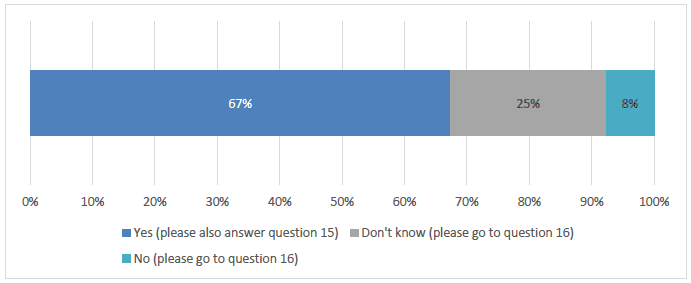
Base: 52
Just over two thirds (67%) agreed that there was a process in place. A quarter (25%) didn't know.
Table 11. Process = Follow-up
| Response option | Number answering open follow-up |
|---|---|
| Yes | 15 |
| No | 1 |
| Don't know | 1 |
Individuals and organisations answering 'Yes' each gave some details of the process for removal of items left in common areas. For organisations, the process generally relies on caretaker/concierge service or contacting the local authority; similarly, for individuals, with one reporting some involvement of SFRS and another, the residents' association.
Organisations suggested that the process might only work when day staff are on duty. The process appears to be a mix of caretakers checking for items, and residents reporting items to caretakers.
One individual respondent answering 'No' gave the example of a Christmas tree in a common area of his building; the building factor wrote to residents advising them to remove it, but this advice was ignored. The respondent went on to explain that there appears to be a process for reporting potential risks, but no process for removing them.
One organisation commented that landlord sanctions enabling actual enforcement would be unlikely to exist without very significant legislative change; going on to state that this would not be the right or proportionate solution. They see the advantage of the SFRS having greater powers, as this means people are more likely to act on instructions from SFRS than from their landlord. The organisation highlighted resourcing issues around supporting further SFRS powers.
"Yes, but it requires the vigilance of one caretaker for 340 flats. Residents who don't understand the dangers won't complain when they should."
Individual owner occupier
"Customers, staff and the general public have a variety of ways to report any concerns surrounding combustible materials in common areas. Concierge staff within our MSF blocks also complete block patrols which includes checking common foyer areas as well as stairs, bin areas, bin chutes and storage areas for combustible material. Any combustible material found is then removed."
Wheatley Group
Question 15. If you answered yes to questions 14; does the process work?
Figure 12. Does process work
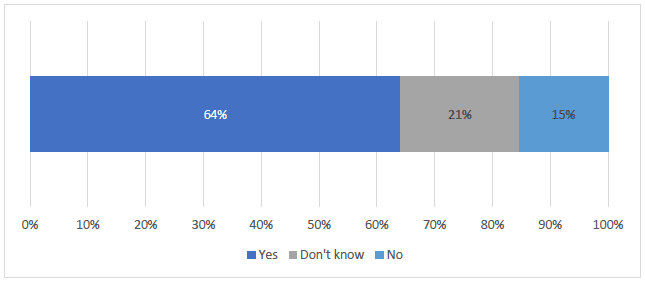
Base: 39
Nearly two thirds (64%) agreed that the process works while nearly a quarter (21%) did not know.
Table 12. Does Process work - follow-up
| Response option | Number answering open follow-up |
|---|---|
| Yes | 15 |
| No | 4 |
| Don't know | 1 |
Individuals answering 'Yes', generally explained that as they are not encountering items in common areas, then the system must work.
Organisations answering 'Yes' tend to qualify their response. Generally, problems encountered are: the length of time taken before action is implemented; the potential failure of the system when there are no night time inspections; some residents being unaware of bulk storage areas and the problems of items removed remaining in bulk storage areas for lengthy periods of time.
Those answering 'No' and commenting were all individuals, their concerns included the price charged for removal of unwanted items by Local Authorities; caretaking resources being spread too thinly; and the perception that a local authority was uncooperative.
Only one individual who selected 'Don't know' made further comment. They mentioend that if there was a process in place residents aren't aware of it.
"Yes and no as Local Authority do not always carry out the removal of said items as quickly as they should."
Organisation
Question 16. What is the best way to get information on keeping common areas safe from fire? Please indicate from 1 to 5 what would be your most and least preferred?
Figure 13. Preferences for receiving information on keeping common areas safe
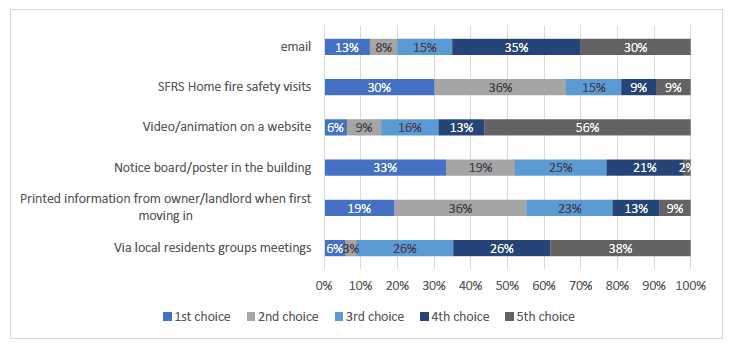
Bases: Email (40), SFRS home fire safety visits (53), video on website (32), notice board/poster (48), printed info on moving in (47), residents meeting (34)
The top preferences for ways to receive information on keeping common areas safe from fire were notice board/poster in the building, SFRS Homes fire safety visits and printed information from owner/landlord when first moving in.
Several respondents stated in their written responses that they found ranking each of the options difficult, with a widely held view that the best approach would use a combination of methods, with some including suggestions for additional methods
Those choosing SFRS home fire safety visits as the preferred option generally stressed that this should be used in conjunction with information from the landlord when moving in. One individual suggested that there should be a partnership approach by landlords and the fire services for new tenants.
Those choosing notice board/poster tended to also give suggestions for other activity; this included: extending residents' groups to include local schools, community groups or local religious groups; local radio/TV and social media campaigns; and Information screens in foyers.
An organisation highlighted that the efficacy of notice boards/posters depends on residents' literacy levels.
The organisation choosing video/animation on website would like to see this used in conjunction with 'rent and council tax letters'.
The organisations that chose not to rank any of the given options would like to see a combination of methods used. Some gave other suggestions for places where residents might be engaged including: Community Centres, Libraries, Housing Area Offices, Doctor's Surgeries and Shopping Centres. There was a suggestion that some material should be made available in Braille.
"Our view is that this is an issue of such importance, a multi-faceted approach to sharing information is essential to engage with as many tenants as possible in ways which will be understandable and engaging for all, taking into account diverse backgrounds, cultures and languages and format preferences."
Maxwellton Court Tenant Association (Secretary) Tenant Renfrewshire Council
Conclusions/Main findings
- Respondents welcomed information to encourage people not to leave items in common areas, but it was acknowledged that there may be people that would ignore the guidance
- Some respondents welcomed the idea of supporting the information with hard hitting images. This being said a few organisations highlighted that there should be a balance between the images being hard hitting and not causing concern or anxiety for residents.
- A campaign to provide information on not leaving items in common areas was thought to be a great idea. Respondents felt a multimedia campaign would be the best approach to take.
- It was mentioned by respondents that a mechanism or method of reporting items in common areas would help. In general, a caretaker/concierge or contacting the Local Authority was the current way of reporting items but no structured or formal mechanism exists.
- A suggestion was made to have SFRS reinforce the importance of not leaving items in common areas as people were more likely to listen to them compared to a landlord.
- Eight out of thirty-nine respondents (21%) didn't know if there is a process for the removal of items and others that knew there was a process didn't know if it worked. Reasons for this are unclear. Clear guidance on processes would be useful.
- With regards to a method for providing information on keeping common areas safe, it was felt that via a noticeboard/poster was the best option following by SFRS home visits and printed information from the landlord when moving in.
Contact
Email: FireDivision@gov.scot
There is a problem
Thanks for your feedback